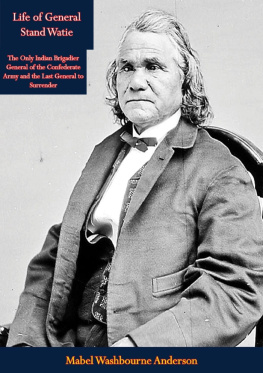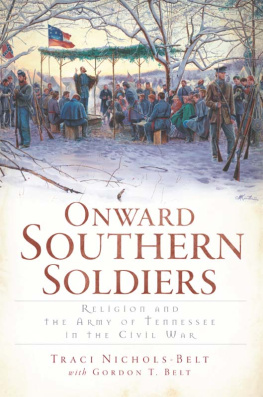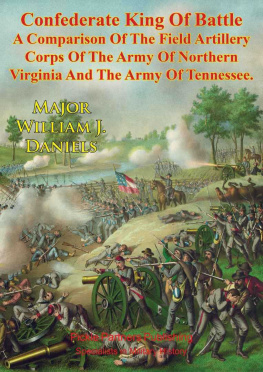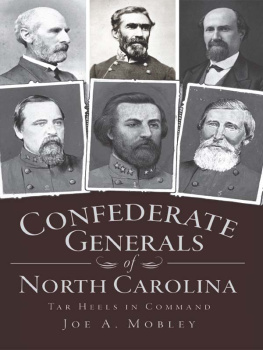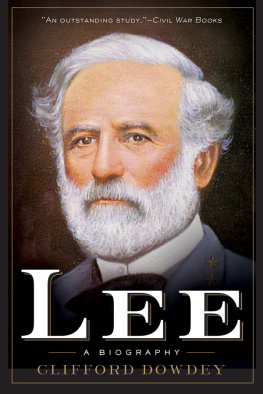Training, Tactics and Leadership in the Confederate Army of Tennessee
First published in 2000 in Great Britain by
Routledge
2 Park Square, Milton Park, Abingdon, Oxon, OX14 4RN
270 Madison Ave, New York NY 10016
Transferred to Digital Printing 2007
Website: www.routledge.com
Copyright 2000 A. R. B. Haughton
British Library Cataloguing in Publication Data
Haughton, Andrew
Training, tactics and leadership in the Confederate Army of Tennessee: Seeds of Failure. (Routledge series. Military history and policy; no. 5)
1. Confederate States of America. Army of Tenessee Drill and tactics 2. Command of troops 3. United States History Civil War, 18611865 4. Confederate States of America History, Military
I. Title
973.7
ISBN10: 0-7146-5032-3 (hbk)
ISBN10: 0-415-44930-8 (pbk)
ISBN13: 978-0-7146-5032-6 (hbk)
ISBN13: 978-0-415-44930-4 (pbk)
ISSN 1465-8488
Library of Congress Cataloging-in-Publication Data
Haughton, Andrew.
Training, tactics and leadership in the Confederate Army of Tennessee / Andrew Haughton.
p. cm. (Routledge series military history and policy, ISSN 1465-8488; no. 5)
Includes bibliographical references (p. ) and index.
ISBN 0-7146-5032-3
1. Confederate States of America. Army of Tennessee Drill and tactics. 2. Military education Confederate States of America History. 3. Command of troops History 19th century. 4. United States History Civil War, 18611865 Campaigns. I. Title. II. Series.
E470.5 .H38 2000
973.7468 dc21
00-022927
All rights reserved. No part of this publication may be reproduced, stored in or introduced into a retrieval system, or transmitted, in any form or by any means, electronic, mechanical, photocopying, recording or otherwise, without the prior written permission of the publisher of this book.
Cover illustration: photograph shows ordinary Confederate soldiers.
Contents
Acknowledgements
Many friends and colleagues have taken time to help with the production of this book during the past four years. They know who they are, and I am deeply indebted to them all. I would like to mention just a few of them here.
Much of my time on this project was spent as a graduate student at Kings College London, where Dr Brian Holden Reid gave me more help and encouragement than any student could expect. Professor Peter Parish and Dr Martin Crawford read and commented on the manuscript, and I am grateful for the benefit of their wisdom. I was also fortunate to meet a number of exceptional young academics in London, and I would like to thank Robert Foley, Jim Beach, Joe Moretz, Martin Samuels, James F. Gentsch and Maria Teresa Oxenstierna for their kind support. Professor Hew Strachan, of Glasgow University, helped get this project started and was a source of good advice throughout my time in London and Glasgow.
During my time in the United States I was treated with amity and encouragement wherever I went, and my thanks go to those who made my trip run so smoothly by efficient assistance and friendliness. Among those who took time from their hectic schedules to proffer ideas and information I must mention Wayne Moore, Chris McGee, Jim Ogden III, Stacy D. Allen, William R. Erwin, Leon Miller, Cathy-Lynn Mundale and Michael Musick. Bruce Gudmundsson, Keith Bohannon and Mark A. Weitz provided information and much food for thought during and after my trip to the United States. Professor Paul Kuntz offered encouragement and advice during my stay at Emory University. Barry Ezell and Gina OKonski did the same in Nashville and New Orleans respectively.
My research was funded primarily by the Student Awards Agency for Scotland, both in London and the United States. Without their help this book may have taken many more years in production, and I am deeply grateful for all their help. Robin Walker also provided sage advice in regard to the funding of the project. Finally, I must thank my family without whom this project could not possibly have come to fruition.
Series Editors Foreword
In the annals of the Confederacy and the historiography of the American Civil War, the Army of Tennessee has always been overshadowed by the Army of Northern Virginia. For Southerners, the latter encapsulated what they thought was most admirable about the Lost Cause. The Army of Northern Virginia revealed redoubtable fighting skills, was audacious in the offence and resolute in the defence; its roll of honour included many victories won against the odds. The Army of Northern Virginia was commanded by a courtly gentleman, Robert E. Lee, a general of consummate skill, and he was ably assisted by such gallant cavaliers as J. E. B. (Jeb) Stuart. The result was an army that best exemplified the elements of the so-called Southern military tradition. Defeat only came, so the legend ran, when Lee and the Army of Northern Virginia were overrun by superior numbers.
The Army of Tennessee, the Confederacys other principal field army, was an organisation that most Southerners, at least until comparatively recent times, would prefer to forget. The Army of Tennessee had only one victory to its credit, Chickamauga in September 1863. And that could be explained by the presence of James Longstreet and his First Corps, transferred from the Army of Northern Virgina in an effort to win back the initiative in the west. Until the publication of Thomas L. Connellys two-volume study, The Army of the Heartland (1967) and Autumn of Glory (1971), only one book had been devoted to its operations. Furthermore, the Army of Tennessees principal commander, Braxton Bragg, did not fit the cavalier stereotype. He was not an inspired and charismatic leader, but a quarrelsome hypochondriac who lacked political finesse. His name became (quite unfairly) a byword for incompetence throughout the Confederacy.
Although Connelly was often critical of the Army of Tennessee and its commanders, he tended also to emphasise the importance of the west to the fortunes of the Confederacy by denigrating Lee and his achievements. To achieve an improvement in the historical reputation of one organisation it is not necessary to cast scorn on another. There is also a danger of placing too much emphasis on personalities and command decisions at the top. Without deviating from Connellys insistence that failures in the west were enormously important in determining the fate of the Confederacy, Andrew Haughton has sought to explain how the Army of Tennessee actually worked . Drawing on a wealth of sources, both unpublished and published, including the letters of soldiers and young officers, Haughtons shrewd, penetrating and instructive book seeks to explain the reasons for the Army of Tennessees long list of tactical failures. As a Scotsman, he can bring a breadth of view and a certain detachment to issues that have sometimes vexed United States historians. It is perhaps no coincidence that he dismisses summarily the argument advanced by Grady McWhiney that Southern armies had a Celtic ethnic character that somehow predisposed them to the attack.
If an army, he writes, goes into battle with an out-of-date and inferior tactical system, it endangers the success of even the best thought out strategic plan. The tactical methods of the Army of Tennessee simply did not evolve. Such a chronic weakness was not rectified even by the best of the Army of Tennessees commanders, Joseph E. Johnston. In support of his analysis, Haughton discusses topics that have tended to be neglected by Civil War historians, such as training and leadership, and he considers the views of middle-ranking officers. Thus, he seeks to explain the mechanics of battle, that is, how the Army of Tennessee actually fought its battles. The result is a provocative and genuinely original contribution to Confederate historiography. Very shortly, Civil War historians will wonder how they managed to work without it.



